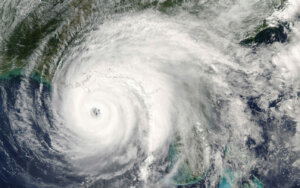Hurricane Season is in Full Effect − Are You Prepared?
 In the U.S., hurricane season officially takes place between June 1st and November 30th. And with hurricane season in full effect now, one of the biggest elephants in the room this year continues to be climate change and its impacts on natural disasters. Scientists actually predict that hurricanes will likely cause increased rainfall and coastal flooding – and possibly become more intense overall over time.
In the U.S., hurricane season officially takes place between June 1st and November 30th. And with hurricane season in full effect now, one of the biggest elephants in the room this year continues to be climate change and its impacts on natural disasters. Scientists actually predict that hurricanes will likely cause increased rainfall and coastal flooding – and possibly become more intense overall over time.
With this in mind, it’s becoming increasingly important that organizations look at climate change and natural disaster preparedness not just from an ESG (environmental, social, and governance) perspective but also from an operational resiliency one. To help with this, it is crucial that organizations invest in operational resilience and business continuity programs so that risk practitioners can more easily identify their business processes, important business services, and the key personnel responsible for those.
And while every organization’s needs are different, there are some key areas that all need to keep top of mind while evaluating their hurricane preparedness plans.
Identifying Business Processes and Important Business Services
It’s one thing to know at a basic level what processes your organization needs to have in place to continue to run and what critical products and services you provide to customers – but it’s another to understand how these different functions interact and what their dependencies are.
A business process can be referred to as a task that takes an input and provides a direct output; you can think of these like payroll, accounts payable, international sales, new hire training, etc. Important business services are the critical services that you provide to your customers; think of mortgage lending, project implementations, ATM services, etc.
Once you have these captured, you can then look at their dependencies and find areas of concern. For example, if you know that the only office that does payroll for your national company is in Florida, that might raise a red flag for you. What if that office is hit by a hurricane? What backup measures are in place? Should you train an additional office on the payroll processes in case of an incident? Another example could be the Miami-based data center that you use for an important business service. By mapping that single point-of-failure location to the critical customer service, you’ll be able to identify that as a risk to your organization.
Considering Your Remote Employees and Conducting Employee Mapping
As organizations move to a permanent work-from-home or hybrid approach (or at least look at hiring talent outside of their normal range), they need to be very mindful of what natural disaster risks that person is subject to and how to mitigate those impacts. It’s one thing to know that you have two remote employees located in New Orleans – it’s another to know what business processes and important business services are critically reliant upon them.
For example, if Janice, who lives in New Orleans, is the only person at your software company who knows how to do accounts payable, what mitigation measures do you have in place in case she is impacted by a hurricane? Is there anyone else trained up to cover for her in the meantime? Can the work be deferred? If she chooses to ride out the storm, will the company provide portable Wi-Fi and backup power to make sure that she can work?
By answering these types of questions and mapping your employees to your processes and services, you can identify critical personnel. This distinction makes a huge difference between knowing that someone somewhere does accounts payable but they have suddenly stopped working, to knowing ahead of time that Janice, who is the only person who does accounts payable, lives in New Orleans and is about to get hit by a hurricane, so let’s prepare accordingly.
Facilitating Hazardous Risk Assessments
As climate change impacts continue to worsen, organizations will want to be more critical of where they open new stores or locations. Performing comprehensive site hazardous risk assessments to determine natural disaster threats, their impact, and their likelihood is becoming increasingly important.
After all, why spend tens of millions of dollars opening a new store right on the Florida coast that scientists predict will be under water in a decade? Will it be enough to make a new store “current hurricane-proof,” or will you need to make your structure and plans more resilient to withstand more frequent or more intense hurricanes? Does the benefit of opening a new location in Key West outweigh the risk of severe tropical weather?
It’s also important to re-evaluate current sites – not just assess future ones. For example, if you use a third-party data center that is located in Florida, it may be worth it to perform an in-depth review of their environmental security and determine if they are resilient enough to keep up with climate change. Are their generators elevated? Do they have lightning rods in place? What are their disaster recovery plans?
Taking Proactive Measures for Hurricane Preparedness
Hurricanes and severe tropical weather are the classic business continuity example of “impacts to people, places, and processes/services.” As these disasters evolve due to climate change, it’s become increasingly apparent that companies need to invest in resiliency programs and approach severe but plausible situations holistically – not with a narrow-lens view. Being proactive in your important business services and processes identification, key personnel mapping, and facilities assessments can foster dividends in years to come.
To ensure that you have all of the proper preparedness programs in place, be sure to request a demo with Fusion or reach out to your Account Manager today.



